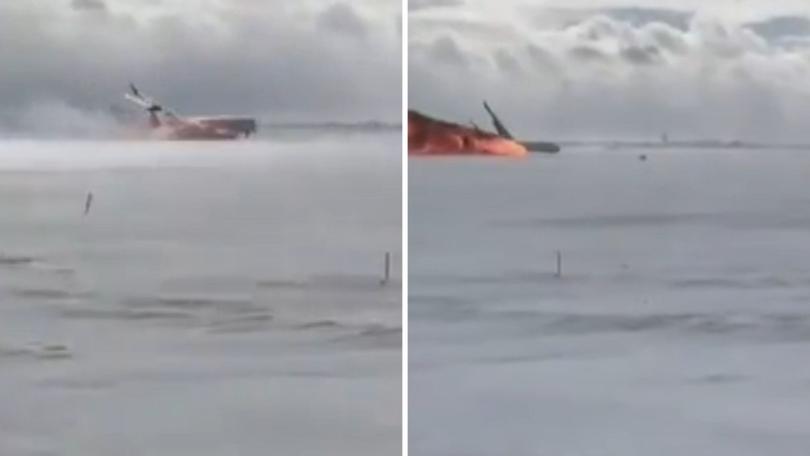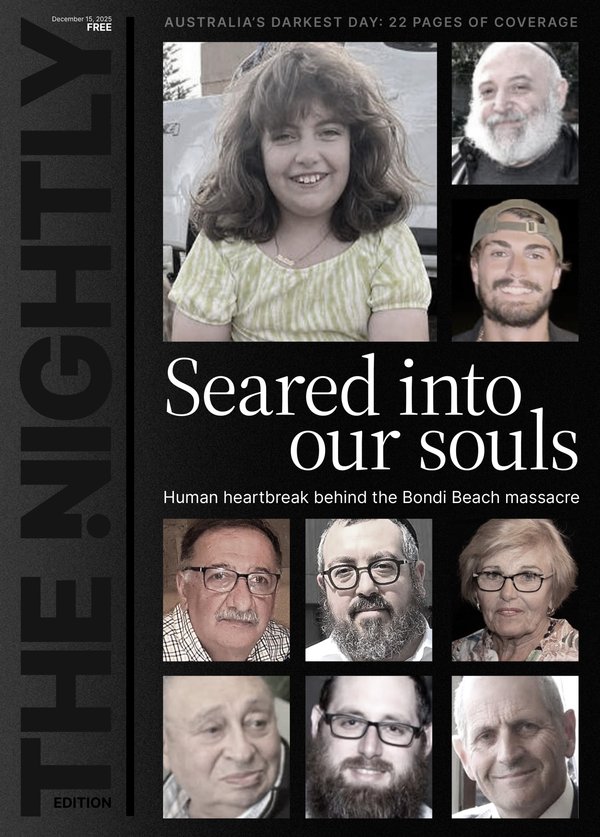Jaw-dropping video emerges of Delta Air Lines plane crash-landing at Toronto Pearson Airport in Canada
New footage has emerged of the moment a Delta Air Lines flight from Minneapolis crashed, turned upside down and caught fire on the runway at Toronto Pearson International Airport in Canada while attempting to land on Monday.
It is the latest in a string of passenger plane crashes since December.
WATCH THE VIDEO ABOVE: Extraordinary new footage of Delta plane crash in Canada.
Sign up to The Nightly's newsletters.
Get the first look at the digital newspaper, curated daily stories and breaking headlines delivered to your inbox.
By continuing you agree to our Terms and Privacy Policy.All 80 people on board the CRJ900 twin-jet aircraft survived, but 21 people were taken to hospitals with injuries, Delta said.
All but two had been released from hospital by Tuesday morning, Delta said.
New video of the crash shows the rear landing gear of the jet buckling and the right wing shearing away in a fireball after the plane landed hard on the runway.
The plane briefly skids on its belly before rolling over, sending smoke and powdery snow shooting into the air.
“Oh, no, no, no, no, no!” says the person taking the video, watching from inside a different plane near the runway.
“When we hit, it was just super hard,” passenger John Nelson said.
“It hit the ground, and the plane went sideways.
“It’s amazing that we’re still here.
“Even now I smell like jet fuel.”
By Tuesday afternoon, the plane wreckage was barely recognisable, camouflaged against the ground by snow plastered across the frozen fuselage, its left wing crumpled and right wing missing.

Monday’s crash is the latest incident in a deadly year for air travel in North America. Earlier this month, 10 people were killed when a regional airline plane crashed in Alaska.
Less than three weeks ago, 67 people were killed when an American Airlines plane collided midair with a US Army Black Hawk helicopter near Washington DC.
Two days later, a medevac jet crashed in Philadelphia, killing all six on board and one person on the ground.
Those disasters were preceded by deadly crashes in December in South Korea and Kazakhstan.
All 80 passengers and crew survived
Delta Flight 4819, operated by Delta subsidiary Endeavor Air, departed from Minneapolis/St Paul International Airport and crashed at the airport, located mostly in the suburb of Mississauga west of Toronto, about 2.15pm ET on Monday, Delta said.
“The hearts of the entire global Delta family are with those affected by today’s incident at Toronto-Pearson International Airport,” Delta CEO Ed Bastian said.
“I want to express my thanks to the many Delta and Endeavor team members and the first responders on site.
“I’m incredibly proud of the professionalism of the Endeavor crew members who evacuated the aircraft, as well as the first responders at Toronto Pearson International Airport and the airport leadership team.”
Toronto Pearson International Airport president and CEO Deborah Flint also credited the “textbook response” of first responders for helping prevent loss of life.
Hard landing left passengers ‘upside down hanging like bats’
Pete Koukov, a passenger on the plane, said he “didn’t know anything was the matter” until they were on the ground.
“We hit the ground, and we were sideways, and then we were upside down hanging like bats,” Koukov said.
Fellow passenger Pete Carlson said: “I took my seat belt off, which I’d obviously left fastened for the landing, and as I took it off, crashed down on to the ceiling which had become the floor.”
Paramedics who responded to the crash treated multiple types of injuries, including back sprains, head lacerations and nausea due to jet fuel fumes, Cory Tkatch from Peel Regional Paramedic Services said.
Video of the crash does not appear to show the usual “flare” of the jet, where the pilot pulls the nose up just before landing, exposing the wings to more air resistance.
“There was no attempt to flare at all, which slows the plane down,” CNN aviation analyst and former US Department of Transportation inspector general Mary Schiavo said.
Koukov said he was able to unbuckle his seat belt, push himself to the ground and then walk out of the plane, but some others needed help getting down from their seats.
“(I) just feeling lucky and happy I got to give the person I didn’t know sitting next to me a big hug, that we were OK, and see my friends who are here to pick me up from the airport and give them a big hug,” he said.
Why did the plane overturn?
The crash happened on a gusty day following heavy snowfall.
“On Thursday and Sunday, we got more than 20 inches (50cm) of accumulated snow,” Flint said on Tuesday.
That is more snowfall than the area received all the previous winter.
“What we can say is the runway was dry, and there was no crosswind conditions,” airport fire chief Todd Aitken said on Monday evening.
However, an air traffic controller told the Delta pilot there were winds of 42km/h, gusting up to 61km/h, blowing across the plane’s path at a 40-degree angle, according to a recording of airport tower radio traffic.
The wind at Pearson was reportedly blowing snow into the air, with a visibility of 8km.
Aitken declined to speak more on the weather conditions on Tuesday, deferring further questions due to the ongoing investigation.
The weather conditions may have become treacherous before the pilots were able to adapt, retired jet pilot Les Abend said.
“With blowing snow, it may have changed rapidly, so the aeroplane that landed ahead of this aircraft may have had a different condition than this particular Delta regional jet,” Abend said.
Videos of the crash could explain why the aircraft overturned after landing, according to former FAA Office of Crash Investigation director Steven Wallace.
“You see the right wing fails, but the aeroplane is still going quite fast, and that left wing is generating a tremendous amount of lift,” Wallace said.
“So that immediately causes the aeroplane to roll inverted. That’s quite clear.”
The runway where the plane crashed is expected to remain closed until at least Thursday evening, according to a notice issued to pilots on Tuesday.
“We do expect that the investigators on-site will be reviewing the aircraft on its current configuration on the runway for the next 48 hours,” Flint said.
The last major aviation accident at the Toronto airport was nearly two decades ago, on August 2, 2005, when an inbound Air France flight from Paris slid off the runway and burst into flames. All 309 people on board survived.
The Transportation Safety Board of Canada is leading the investigation, with help from the National Transportation Safety Board in the US.
Originally published on CNN
